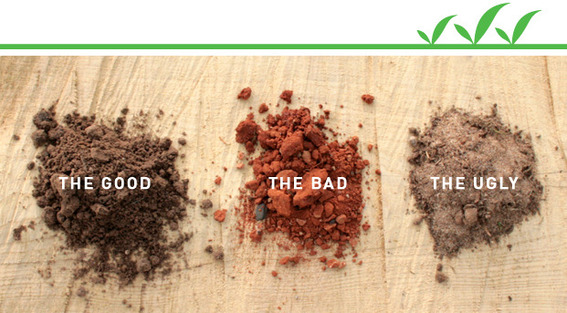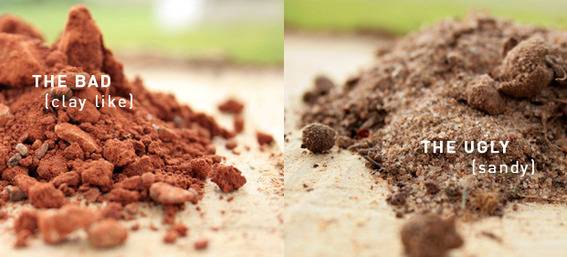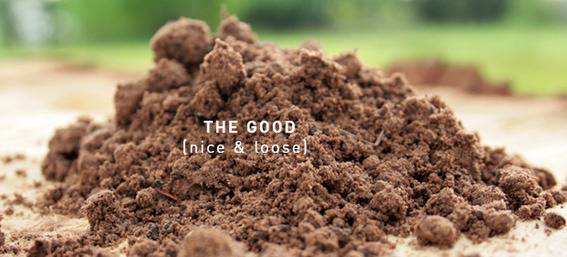Let’s talk about something that can make or break your gardening success this season: soil quality! So many garden failures can be traced back to poor soil conditions.
Think of good soil like a well-stocked pantry that provides everything your plants need to thrive, while bad soil is more like an empty refrigerator that leaves your plants hungry and struggling.
Understanding the difference between dirt and soil might sound basic, but it’s the foundation of a thriving garden!
Navigate This Post
The Difference Between Dirt and Soil
First, let’s clear something up – dirt and soil aren’t the same thing!
Dirt is what you sweep off your floors, while soil is a living ecosystem that supports plant growth. Good soil is alive with beneficial bacteria and fungi that create a healthy soil food web.
This living soil structure contains organic matter and has the right composition to support plants’ roots.
When gardeners talk about “building soil,” they’re talking about transforming lifeless dirt into this rich, living habitat that plants love.

Good Soil vs Bad Soil
The contrast between good soil and bad soil is dramatic once you know what you’re looking for.
Good soil crumbles easily in your hand, has a pleasant earthy smell, and is home to visible organisms like worms and beneficial insects.
When it rains, good soil absorbs water without becoming waterlogged or forming puddles.
Bad soil, on the other hand, often has warning signs you can spot right away.
It might be extremely compacted and hard to till.
It could form a tight ball when wet that doesn’t break apart, indicating issues with soil structure. Or it might be so sandy that it can’t hold moisture at all.
Bad soil typically lacks that rich, dark color and may appear pale, reddish, or grayish.
When you dig into bad soil, you’ll rarely find worms or other signs of biological activity, and it might be more susceptible to pests and disease.
The good news is that even bad soil can be rehabilitated with consistent care and the right amendments.
Remember that soil is a living system that responds to how we treat it – with some attention to soil health, even challenging soil can be transformed over time.
What Does Good Soil Look Like?
Wondering how to tell if you’ve got the good stuff?
Good soil vs bad soil is easy to spot once you know what to look for. The three key elements of healthy garden soil are:
1. Nutrients
Good soil has a rich dark color – usually deep brown or black – which indicates high carbon content. If your soil is very sandy, clay-heavy, or an unusual reddish color, it might need some help.
Plants need adequate levels of nitrogen, phosphorus, and potassium for proper growth. You can add nutrients through:
- Composting kitchen scraps and yard waste
- Adding organic matter like grass clippings or leaves
- Incorporating nutrient-rich amendments like coffee grounds, fireplace ash, and even crushed eggshells
- Using organic fertilizers to supplement specific nutrients
The composition of your soil directly affects how well plants can access these essential nutrients.
2. Aeration and Soil Texture
This is all about the “fluffiness” or texture of your soil and how soil particles arrange themselves.
When you squeeze good soil in your hand, it should hold together when pressed but crumble easily when you open your fingers. Plants’ roots need to easily navigate through soil to access nutrients and water.
Soil texture is determined by the proportion of sand, silt particles, and clay in your soil.
If your soil is too dense or clay-like (often appearing dark red or black with a sticky consistency), you can improve aeration and reduce soil compaction by adding:
- Peat moss
- Pecan shells
- Peanut husks
- A little sand (perfect for heavy clay soils)
Breaking up compacted soil and adding these elements will create the perfect soil structure your plants need to thrive.
Soil aggregates, which are clusters of soil particles bound together, help create pore spaces for air and water movement.

Sandy Soil vs Clay Soil: The Common Extremes
When diagnosing your garden’s soil quality, you’ll likely encounter one of two common challenges: sandy soil or clay soil. Both present unique issues, but with some targeted amendments, you can improve either type!
Sandy Soil
Sandy soil feels gritty between your fingers and doesn’t hold its shape when squeezed. While it warms up quickly in spring (a plus for eager gardeners!), it drains too rapidly and doesn’t retain nutrients well. Plants in sandy soil often struggle because water and nutrients wash away before roots can absorb them.
To improve sandy soil:
- Add organic matter like compost, well-rotted manure, or leaf mold
- Mulch heavily to reduce water evaporation
- Consider adding coconut coir which holds moisture better than peat moss
- Use cover crops during off-seasons to build organic content and increase carbon levels
- Avoid excessive tillage which can further deteriorate soil structure
Clay Soil
Clay soil feels sticky when wet and dries into hard, cracked surfaces. It holds moisture and nutrients well—sometimes too well, leading to poor drainage and root rot. Clay soil warms slowly in spring and can become compacted easily, making it difficult for roots to penetrate. The dense structure limits the diversity of plants that can thrive in it.
To improve clay soil:
- Add coarse organic material like composted bark
- Incorporate agricultural gypsum to help break apart clay particles
- Never work clay soil when wet—wait until it’s just slightly damp
- Consider raised beds as a faster solution while you gradually improve the native soil
- Use specific soil amendments to improve soil texture and characteristics
Remember that soil improvement is a journey, not a destination.
Even challenging soil types can become garden-friendly with consistent attention to soil layers and the right amendments.
Many experienced gardeners find that annual additions of compost and organic matter will gradually transform both sandy and clay soils into that perfect loamy texture we all dream about for vegetable gardens!
3. Volume and Soil Depth
Many of us focus only on the top few inches of our gardens, but plants need depth to develop strong root systems.
Most plants need at least 12-18 inches of good soil depth to truly flourish. Adequate soil depth helps prevent disturbance to the soil food web and allows for better nutrient cycling.
For in-ground gardens, try double-digging your beds to loosen and improve soil at a deeper level.
This creates distinct soil layers that encourage root growth.
Even container gardens need attention to soil depth – those cute small pots might not provide enough room for your plants to develop strong roots.

Creating a Balanced Soil Habitat
The ultimate goal is to create a balanced soil environment where beneficial bacteria, fungi, worms, and other soil organisms can thrive alongside your plants.
These organisms break down organic matter, cycle nutrients, and even help protect plants from certain pests and diseases.
Consider each garden bed as its own ecosystem, with soil as the foundation.
By nurturing the life in your soil, you’re creating a self-sustaining habitat that will reward you with healthier, more productive plants. As your soil heAae diversity of plants you can grow successfully will increase.
Transform Your Garden’s Foundation
Whether you’re starting a new garden or refreshing an existing one, taking the time to understand and improve your soil will make all the difference in your results. Remember, great gardens start from the ground up!
Have you had dramatic improvements after fixing your soil quality? We’d love to hear your soil transformation stories in the comments below!

This was my second summer in this house and the yard has been a big disapointment. I have two 300 year old trees at the bottom of the yard and I think they are sending tiny little roots all over my yard. In the early spring a bed that my husband had dug for me as well as putting the soil through a big sieve was surprisingly hard for me to dig when I wanted to put plants or shrubs in. I put trumpet vines (3) against a trellis the first year but even after this second summer one grew to be about 5 feet high and two fee wide while the other two were only two feet and one foot high. I have nasturtiums that are 3 inches high, snap dragons half the height they should be and hostas that are about one tenth the size that I had in my last yard. I took a fern that was living a terrible life, (or so I thought) from under a hedge in the front street and put it in my yard and now it looks like someone cut the ends of it besides that it is very small. My soil looks very grey and dries out very fast. What do you think is the main problem here? Loraine
Loraine,
Soil, sounds like a soil problem.
I would get the soil tested. Usually you can get a free soil test through your local Ag extension of you’re state college Ag network.
That will start to tell you how to feed the soil and feed you’re plants. If you have the time you can develop the soil slowly be adding compost and specific fertilizer mixes to develop the soil. This could take a couple of years.
If you want something faster, it will be more costly, but you can replace the soil in a specific area. You can dig out the flower beds and bring in specific hot mix soils for flower beds and plants.
That’s where I would start. Otherwise it’s going to take time for any plants to get going and develop because they are going to have to put down extensive root systems in order to get the nutrients they need to live. This is probably why the trees are running out extra feeder roots close to the surface.
Hope this helps! – Cale
Thanks so much for your answer, Cale. I have dug all around a few shrubs that I put in two years ago and replaced the old soil with some really good soil that I bought. Hopefully that will help a bit. I live in Vancouver, Canada so gardening is kind of ending now until next spring. I think I will get some new soil
in the spring and put it in my beds. Thanks again, Loraine Cassidy
great tips